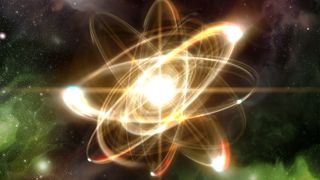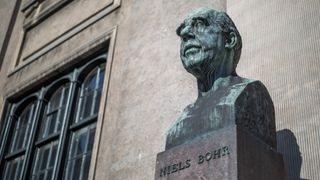Electrons: Facts about the negative subatomic particles
Electrons allow atoms to interact with each other.

Electrons are negatively charged subatomic particles found in the outermost regions of atoms. They are considered to be both partially particle-like and partially wave-like, depending on the scenario, according to West Texas A&M University. Electrons are essentially the reason atoms can interact with other atoms.
The nucleus of an atom consists of protons and neutrons. Protons are positively charged, neutrons have no charge and electrons are negatively charged, according to the educational website Lumen Learning. The properties of an atom depend on the arrangement of these basic particles.
According to BBC Bitesize, if an atom were the size of Earth, the diameter of the nucleus would be equivalent to just 853 feet (260 meters).
Electrons are about 1,800 times smaller in mass than protons and neutrons, therefore, they do not contribute significantly to an element's atomic mass. The mass of an atom is primarily derived from protons and neutrons which have approximately the same mass — about 1.67 × 10^-24 grams — defined as one atomic mass unit (amu) or one Dalton, according to Lumen Learning.
An atom's charge, however, is significantly affected by electrons. A proton's positive charge is equal to an electron's negative charge therefore an uncharged — neutral — atom has an equal number of protons and electrons.
Related: The four fundamental forces of nature
| Header Cell - Column 0 | Charge | Mass (amu) | Location |
|---|---|---|---|
| Proton | +1 | 1 | Nucleus |
| Neutron | 0 | 1 | Nucleus |
| Electron | -1 | 0 | Orbitals |
Electron orbitals and the Bohr Model
Electrons surround the atomic nucleus in regions of space known as orbitals. According to the educational website Cambridge Coaching, an electron orbital is an area surrounding the nucleus where there is a high probability (over 90%) of finding an electron. "Orbitals are not an exact place but rather an area that includes that exact place" according to Cambridge Coaching. Each orbital can hold up to two electrons, according to the educational website Khan Academy
An early atom model — known as the Bohr Model — developed by Danish scientist Niels Bohr in 1913, depicts electron shells circling the atomic nucleus, similar to planets orbiting the sun, according to the Khan Academy. Each electron shell is made up of one or more subshells which are essentially sets of one or more orbitals.

Each electron shell has a different energy level. Electron shells closest to the nucleus are lower in energy than those farther away. Electrons can move between these shells by either absorbing or releasing energy. This absorption or release of energy must be the same as the energy difference between the shells if an electron is to successfully move between them.
According to the Khan Academy, for an atom to be stable it must exhibit the lowest energy configuration it can. Therefore electrons "fill up" the lower energy shells closest to the nucleus first before they move to higher-energy shells further out.
Electron configurations: What are they?
Though the Bohr Model can be a useful tool for understanding electron shell distribution and energy levels. It doesn't fully represent the reality of what is going on concerning electron configuration.
Electron configurations help chemists predict how an atom will behave in areas regarding conductivity, stability and boiling point, according to Los Alamos National Laboratory. The configurations tell scientists how electrons are distributed between subshells.
Subshells are designated by letters s, p, d and f which relate to the shape of the orbital, for example, s subshells have one spherical orbital, according to the Khan Academy. The superscript letter that accompanies s, p d and f in electron configurations refers to the number of electrons in that orbital.
For more information on electron configurations and how to calculate them for yourself, check out this useful electron configuration resource from Cambridge Coaching.
History of electrons
Electrons were discovered by English physicist Joseph John Thomson in 1897. Thomson carried out experiments that involved discharging electricity through gases at low pressures, according to the University of Cambridge. Gases are usually poor conductors of electricity but when contained at low pressures and a voltage is applied via two electrodes, the gas becomes conductive.
During this conduction, the negative cathode appears to emit bright lines known as cathode rays. These rays were first described in 1858 by German physicist Julius Plücker, according to The Royal Society. But nobody knew what was causing them.
There were two main theories at the time. One was that the rays were caused by some sort of radiation and the other was that they were streams of mysterious negatively charged particles, according to the University of Cambridge. Thomson then successfully confirmed the latter theory was correct and these particles came to be known as electrons.
In 1910, Thomson began to work with Francis Aston, their work on gas conductivity influenced the development of Aston's spectrometer and the discovery of isotopes, according to Chemistry World.
Thomson's scientific achievements didn't go unnoticed. In 1906, Thomson received the Nobel Prize for "his theoretical and experimental researches on the discharge of electricity through gases." In 1908, he was knighted and in 1912, he received the Order of Merit, which was founded to award those who had provided "exceptionally meritorious service in Our Crown Services or towards the advancement of Arts, Learning, Literature, and Science," according to the U.K. journal of record The Gazette. Thomson was also the President of the Royal Society for five years (1915 to 1920) and Master of Trinity College Cambridge until his death on Aug. 30, 1940.
Additional resources
Explore electron configurations in more detail and complete some learning exercises with Chemistry LibreTexts or discover a variety of interesting experiments involving electrons and light. Learn about what happens when two non-metal atoms share a pair of electrons in what is known as a covalent bond, with BBC Bitesize.
Bibliography
Navarro, Jaume. A History of the Electron: JJ and GP Thomson. Cambridge University Press, 2012.
Münzenberg, G. "Development of mass spectrometers from Thomson and Aston to present." International Journal of Mass Spectrometry 349 (2013): 9-18.
Kragh, Helge. Niels Bohr and the quantum atom: The Bohr model of atomic structure 1913-1925. OUP Oxford, 2012.
McKagan, S. B., K. K. Perkins, and C. E. Wieman. "Why we should teach the Bohr model and how to teach it effectively." Physical Review Special Topics-Physics Education Research 4.1 (2008): 010103.
Itatani, Jiro, et al. "Tomographic imaging of molecular orbitals." Nature 432.7019 (2004): 867-871.
Join our Space Forums to keep talking space on the latest missions, night sky and more! And if you have a news tip, correction or comment, let us know at: community@space.com.
Get the Space.com Newsletter
Breaking space news, the latest updates on rocket launches, skywatching events and more!

Daisy Dobrijevic joined Space.com in February 2022 having previously worked for our sister publication All About Space magazine as a staff writer. Before joining us, Daisy completed an editorial internship with the BBC Sky at Night Magazine and worked at the National Space Centre in Leicester, U.K., where she enjoyed communicating space science to the public. In 2021, Daisy completed a PhD in plant physiology and also holds a Master's in Environmental Science, she is currently based in Nottingham, U.K. Daisy is passionate about all things space, with a penchant for solar activity and space weather. She has a strong interest in astrotourism and loves nothing more than a good northern lights chase!
